- Munyaka and Opiyo commenced trading on 1 May 2002 as wholesalers, sharing profits and losses in the ration 2:1, after allowing interest on the capital...(Solved)
Munyaka and Opiyo commenced trading on 1 May 2002 as wholesalers, sharing profits and losses in the ration 2:1, after allowing interest on the capital introduced by the partners at the rate of 10% per annum. Opiyo was to receive a salary of Sh. 440,000 per annum. Munyaka and
Opiyo do not operate a complete set of accounting records.
The following summary of the bank statements for the year ended 30 April 2003 has been provided:
Receipts: Cash introduced as capital on 1 May 2002: Munyaka Sh. 3,500,000 and Opiyo
Sh. 2,000,000. Balance of receipts from customers amounted to Sh. 12,700,000.
Payments: Equipment Sh. 2,500,000: Pick-up Sh. 1,000,000: furniture and fittings Sh.
375,000: go-down rental Sh. 375,000, wages Sh. 1,772,000; salary of Sales
Manager Sh. 1,200,000; purchases for resale Sh. 9,900,000; rates Sh. 200,000;
repairs Sh. 62,500; insurance Sh. 55,000; motor expenses Sh. 186,500.
The following cash payments were made before banking the balance of the takings; Motor
expenses Sh. 129,000, wages Sh. 148,000; Sundry expenses Sh. 25,000; Drawings – Munyaka
Sh. 7,500 per week and Opiyo Sh. 6,000 per week.
Additional information:
1. The partners had taken goods for their domestic use as follows:
Munyaka Sh. 50,000; Opiyo Sh. 75,000 (both at selling price).
2. During the year to 30 April 2003, discounts allowed to customers amounted to Sh.
122,500 while discounts received from suppliers amounted to Sh. 55,000.
3. At 30 April 2003,l the amounts owing to suppliers amounted to Sh. 750,000 and the
amount owing by customers was Sh. 1,550,000. An amount of Sh. 200,000 owing by a
customer proved irrecoverable and was treated as a bad debt.
4. As at 30 April 2003, rates and insurance were prepaid to the extent of Sh. 25,000 and
Sh. 5,000 respectively. Stock on hand at cost amounted to Sh. 1,205,000.
5. The go-down had been occupied since 1 May 2002 at an annual rental of Sh. 500,000.
6. Depreciation is to be provided on a straight-line basis as follows: Motor vehicles 20%
per amount: Equipment, furniture and fittings at the rate of 10% per annum.
Required:
(a) Trading, profit and loss and appropriation accounts for the year ended 30 April 2003.
(b) Balance sheet as at 30 April 2003.
(Assume a 52 – week year)
Date posted: November 17, 2018.
- The following balances remained in the books of Ahadi Ltd. as at 30 April 2003 after the preparation of the trading account:(Solved)
The following balances remained in the books of Ahadi Ltd. as at 30 April 2003 after the preparation of the trading account:
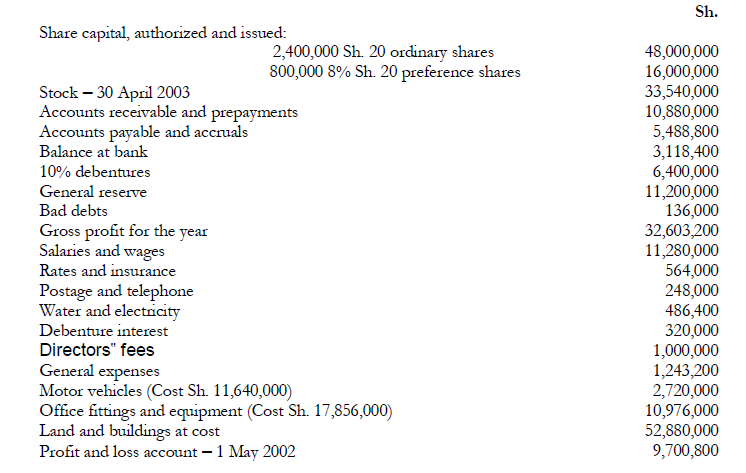 Additional information:
1. A bill for Sh. 219,200 in respect of electricity for the period up to 30 April 2003 has
not been accrued.
2. The amount for insurance includes a premium of Sh. 120,000 paid in January 2003
to cover the company for six months, February to July, 2003.
3. Office fittings and equipment are to be depreciated at 15% per annum on cost
and motor vehicles at 20% per annum on cost.
4. Provision is to be made for:
Directors‟ fees - Sh. 2,000,000
Audit fee - Sh. 480,000
The outstanding debenture interest.
5. The directors have recommended that:
- A sum of Sh. 4,800,000 be transferred to general reserve.
- The preference dividend be paid.
- A 10% ordinary dividend be paid.
Required:
(a) Profit and loss and appropriation accounts for the year ended 30 April 2003.
(b) Balance sheet as at 30 April 2003.
Additional information:
1. A bill for Sh. 219,200 in respect of electricity for the period up to 30 April 2003 has
not been accrued.
2. The amount for insurance includes a premium of Sh. 120,000 paid in January 2003
to cover the company for six months, February to July, 2003.
3. Office fittings and equipment are to be depreciated at 15% per annum on cost
and motor vehicles at 20% per annum on cost.
4. Provision is to be made for:
Directors‟ fees - Sh. 2,000,000
Audit fee - Sh. 480,000
The outstanding debenture interest.
5. The directors have recommended that:
- A sum of Sh. 4,800,000 be transferred to general reserve.
- The preference dividend be paid.
- A 10% ordinary dividend be paid.
Required:
(a) Profit and loss and appropriation accounts for the year ended 30 April 2003.
(b) Balance sheet as at 30 April 2003.
Date posted: November 17, 2018.
- You have recently been employed in a medium size company and deployed in the accounts department. Your head of section has given you the following...(Solved)
You have recently been employed in a medium size company and deployed in the accounts department. Your head of section has given you the following extract from the cashbook for the month of April 2003.
 The head of section further informs you that all receipts are banked intact and all payments are
made by cheque. On investigation, you discover the following:
1. Bank charges and commissions amounting to Sh. 272,000 entered on the bank
statement had not been entered in the cashbook.
2. Cheques drawn amounting to Sh. 534,000 had not been presented to the bank for
payment.
3. Cheques received totaling Sh. 1,524,000 had been entered in the cashbook and paid into
the bank, but had not been credited by the bank until May 2003.
4. A cheque for Sh. 44,000 had been entered as a receipt in the cashbook instead of a
payment.
5. A cheque for Sh. 50,000 had been debited by the bank by mistake.
6. A cheque received for Sh. 160,000 had been returned unpaid. No adjustment had been
made in the cashbook.
7. All dividends receivable are credited direct to the bank account. During the month of
April 2003. Dividends totaling Sh. 124,000 were credited by the bank and no entries had
been made in the cashbook.
8. A cheque drawn for Sh. 12,000 had been incorrectly entered in the cash book as Sh.
132,000.
9. The balance brought forward should have been Sh. 1,422,000.
10. The bank statement as at 30 April 2003 showed on overdraft of Sh. 2,324,000.
Required:
(i) The adjusted cashbook as at 30 April 2003.
(ii) Bank reconciliation statement as at 30 April 2003.
The head of section further informs you that all receipts are banked intact and all payments are
made by cheque. On investigation, you discover the following:
1. Bank charges and commissions amounting to Sh. 272,000 entered on the bank
statement had not been entered in the cashbook.
2. Cheques drawn amounting to Sh. 534,000 had not been presented to the bank for
payment.
3. Cheques received totaling Sh. 1,524,000 had been entered in the cashbook and paid into
the bank, but had not been credited by the bank until May 2003.
4. A cheque for Sh. 44,000 had been entered as a receipt in the cashbook instead of a
payment.
5. A cheque for Sh. 50,000 had been debited by the bank by mistake.
6. A cheque received for Sh. 160,000 had been returned unpaid. No adjustment had been
made in the cashbook.
7. All dividends receivable are credited direct to the bank account. During the month of
April 2003. Dividends totaling Sh. 124,000 were credited by the bank and no entries had
been made in the cashbook.
8. A cheque drawn for Sh. 12,000 had been incorrectly entered in the cash book as Sh.
132,000.
9. The balance brought forward should have been Sh. 1,422,000.
10. The bank statement as at 30 April 2003 showed on overdraft of Sh. 2,324,000.
Required:
(i) The adjusted cashbook as at 30 April 2003.
(ii) Bank reconciliation statement as at 30 April 2003.
Date posted: November 17, 2018.
- Briefly explain why it is important for a business entity to prepare a bank reconciliation statement(Solved)
Briefly explain why it is important for a business entity to prepare a bank reconciliation statement
Date posted: November 17, 2018.
- Differentiate between a petty cashbook and a three-column cashbook(Solved)
Differentiate between a petty cashbook and a three-column cashbook.
Date posted: November 17, 2018.
- The following balances have been extracted from the books of Limuru Manufacturers, a small scale manufacturing enterprise, as at 31 December 2002:(Solved)
The following balances have been extracted from the books of Limuru Manufacturers, a small scale manufacturing enterprise, as at 31 December 2002:
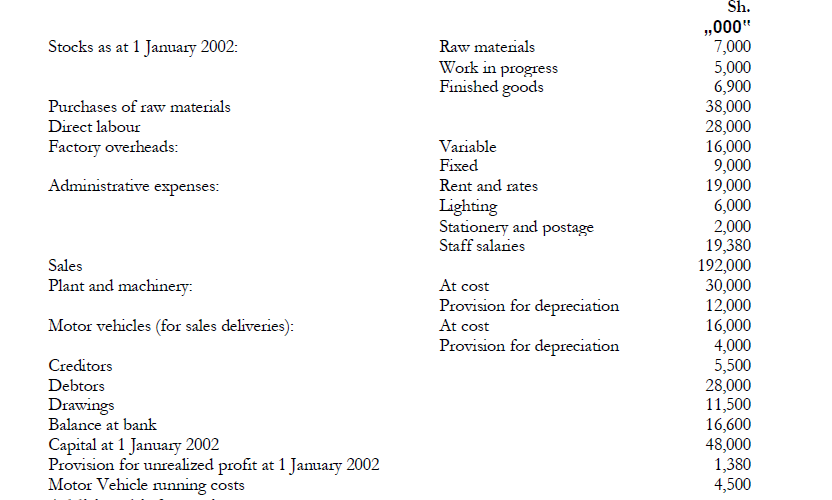
 2. The factory output is transferred to the trading account at factory cost plus 25%
of factory profit.
3. Depreciation is provided at the rates shown below on the original cost of fixed
assets held at the end of each financial year.
Plant and machinery - 10% per annum
Motor vehicles - 25% per annum
4. Amounts accrued at 31 December 2002 for direct labour amounted to Sh. 3,000,000
and rent and rates prepaid at 31 December 2002 amounted to Sh. 2,000,000.
Required:
(a) Manufacturing, trading and profit and loss account for the year ended 31 December
2002.
(b) Balance sheet as at 31 December 2002.
2. The factory output is transferred to the trading account at factory cost plus 25%
of factory profit.
3. Depreciation is provided at the rates shown below on the original cost of fixed
assets held at the end of each financial year.
Plant and machinery - 10% per annum
Motor vehicles - 25% per annum
4. Amounts accrued at 31 December 2002 for direct labour amounted to Sh. 3,000,000
and rent and rates prepaid at 31 December 2002 amounted to Sh. 2,000,000.
Required:
(a) Manufacturing, trading and profit and loss account for the year ended 31 December
2002.
(b) Balance sheet as at 31 December 2002.
Date posted: November 17, 2018.
- Write short notes to distinguish the following:
(a) Purchased goodwill and non-purchased goodwill.
(b) Amortisation and depreciation of fixed assets.
(c) Provisions and reserves.
(d) Compensating errors and errors...(Solved)
Write short notes to distinguish the following:
(a) Purchased goodwill and non-purchased goodwill.
(b) Amortisation and depreciation of fixed assets.
(c) Provisions and reserves.
(d) Compensating errors and errors of principle
Date posted: November 17, 2018.
- Denticare Limited makes its accounts on 30 June every year. On 1 July 2001, the company's balance sheet included the following figures for non -current...(Solved)
Denticare Limited makes its accounts on 30 June every year. On 1 July 2001, the company's balance sheet included the following figures for non-current assets:
 The company's policy is to charge depreciation at the following rates:
The company's policy is to charge depreciation at the following rates:
 A proportionate charge is made in the year of purchase, sale or revaluation of an asset.
During the year ended 30 June 2002, the following transactions took place:
1. On 1 January 2002 the company decided to adopt a policy of revaluing its buildings. A
professional valuer engaged for this purpose revalued the buildings at Sh.34
million.
2. On 1 Janua ry a plant that had cost Sh.3 million was sold for Sh.500, 000. Accumulated
depreciation on this plant on 30 June2001 amounted to Sh.2.3 million. A new plant was
then purchased at a cost of Sh.4 million.
3. On 1 April 2002 a new motor vehicle was purchased for Sh.300, 000 Part of the
purchase price was settled by exchanging another motor vehicle at an agreed value of
sh.120, 000 The balance of Sh.180,000 was paid in cash. The vehicle which was given in
part exchange had cost Sh.200, 000 and had a net book value of Sh.100, 000 as at 30
June 2001
Required:
(a) The following ledger accounts to record the above transactions:
(i) Buildings account.
(ii) Provision for depreciation: Buildings.
(iii) Plant and machinery account.
(iv) Provision for depreciation: Plant and Machinery.
(v) Motor vehicles account.
(vi) Provision for depreciation: Motor vehicles.
(b) Property, plant and equipment movement schedule for the year ended 30 June 2002.
A proportionate charge is made in the year of purchase, sale or revaluation of an asset.
During the year ended 30 June 2002, the following transactions took place:
1. On 1 January 2002 the company decided to adopt a policy of revaluing its buildings. A
professional valuer engaged for this purpose revalued the buildings at Sh.34
million.
2. On 1 Janua ry a plant that had cost Sh.3 million was sold for Sh.500, 000. Accumulated
depreciation on this plant on 30 June2001 amounted to Sh.2.3 million. A new plant was
then purchased at a cost of Sh.4 million.
3. On 1 April 2002 a new motor vehicle was purchased for Sh.300, 000 Part of the
purchase price was settled by exchanging another motor vehicle at an agreed value of
sh.120, 000 The balance of Sh.180,000 was paid in cash. The vehicle which was given in
part exchange had cost Sh.200, 000 and had a net book value of Sh.100, 000 as at 30
June 2001
Required:
(a) The following ledger accounts to record the above transactions:
(i) Buildings account.
(ii) Provision for depreciation: Buildings.
(iii) Plant and machinery account.
(iv) Provision for depreciation: Plant and Machinery.
(v) Motor vehicles account.
(vi) Provision for depreciation: Motor vehicles.
(b) Property, plant and equipment movement schedule for the year ended 30 June 2002.
Date posted: November 17, 2018.
- Masaba Company Ltd. is a retail provider with an authorised share capital of 800,000 Sh.20 ordinary shares and 250,000 8% Sh.20 redeemable preference shares.
The following...(Solved)
Masaba Company Ltd. is a retail provider with an authorised share capital of 800,000 Sh.20 ordinary shares and 250,000 8% Sh.20 redeemable preference shares.
The following financial information reflects the position of the company as at 31 December
2001 after preparing the Trading, profit and loss account:
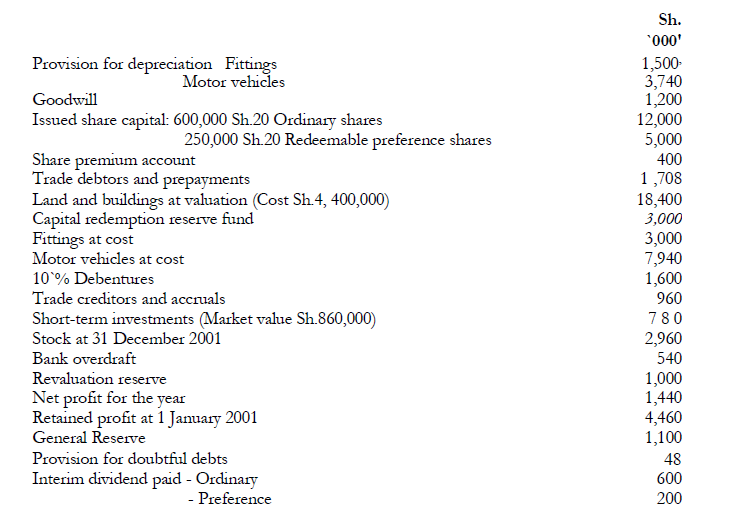 The following resolutions relating to year ended 31 December 2001 have been passed by the
board of directors of the company
1. Transfer Sh.500,000 to General Reserve.
2. Provide for 5% final dividend and final preference dividend on shares issued
and outstanding on 31 December 2001.
3. Make a bonus issue of 100,000 fully paid ordinary shares from the retained profits
account.
Required:
(i) The appropriations account of Masaba Company Ltd. for the year ended 31 December
2001.
(ii) The balance sheet of Masaba Company Ltd. as at 31 December 2001.
The following resolutions relating to year ended 31 December 2001 have been passed by the
board of directors of the company
1. Transfer Sh.500,000 to General Reserve.
2. Provide for 5% final dividend and final preference dividend on shares issued
and outstanding on 31 December 2001.
3. Make a bonus issue of 100,000 fully paid ordinary shares from the retained profits
account.
Required:
(i) The appropriations account of Masaba Company Ltd. for the year ended 31 December
2001.
(ii) The balance sheet of Masaba Company Ltd. as at 31 December 2001.
Date posted: November 17, 2018.
- Explain the legal provisions regarding the establishment and subsequent use of the following reserves: (i) Share premium account. (ii) Capital redemption reserve fund.(Solved)
Explain the legal provisions regarding the establishment and subsequent use of the following reserves: (i) Share premium account. (ii) Capital redemption reserve fund.
Date posted: November 17, 2018.
- The Swara Sports Club had the following assets and liabilities as at 30 September 2002(Solved)
The Swara Sports Club had the following assets and liabilities as at 30 September 2002:
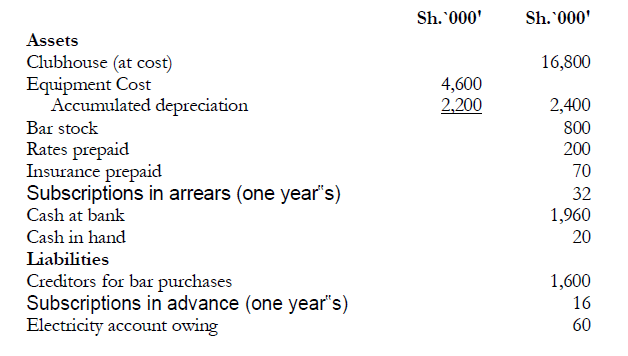 The treasurer of the club, Mr. Lutomia is in process of drawing up the financial forecast of
the club for the coming year, ending on 30th September2003.
He wishes to prepare a forecast income and expenditure account for the year and a balance
sheet as at that date.
The following information has been collected to assist in the forecast:
1. The club has 300 members and it is intended to raise the subscriptions per member
from the current Sh.8,000 to Sh.10,000 per year. The members who have paid in
advance will be allowed subscriptions at the old rates. It is anticipated that the members
currently in arrears with their subscriptions will pay the arrears during the coming year.
It is also anticipated that the number of members whose subscriptions would be in
arrears and those who would have paid in advance on 30 September 2003 would be the
same as the corresponding numbers on 30 September 2002.
2. Extensions to the clubhouse are planned which will cost an estimated amount of
Sh.3,000,000. Of this sum, it is anticipated that Sh.2, 000,000 will be paid during the
year.
3. Some of the club's sports equipment which cost Sh.500,000 and has a written value of
Sh.200,000 will be sold for u estimated value of Sh.100,000 and replaced by new
equipment costing Sh.680,000. All equipment is depreciated on a straight-line basis over
four years and none of the equipment is more than three years old. A full year's
provision is charged in the year of acquisition and none in the year of disposal.
4. Bar purchases are made monthly on credit and paid for in the month following
purchase. It is anticipated that the same volume of business, which is fairly constant on
a monthly basis, will be realised during the coming year but that stock costs will rise by
25% from 1 October 2002. Bar stocks are normally held at the level of one half of one
month's purchases. The bar makes a gross profit margin of 20% on all sales regardless
of stock costs. Bar sales are on cash, all of which is banked daily. The barman, who is
paid Sh.20,000 per month, receives a commission of 5% of the gross profit for the year.
This is paid with his final wage cheque by the year end.
5. The club runs monthly social evenings and charges members Sh.2, 000 per head
admission. An average of 200 members attend each of these evenings. Expenses usually
amount to Sh. 1,400 per head.
6. The following expenditure payments are expected to be made by the club during the
coming year:
The treasurer of the club, Mr. Lutomia is in process of drawing up the financial forecast of
the club for the coming year, ending on 30th September2003.
He wishes to prepare a forecast income and expenditure account for the year and a balance
sheet as at that date.
The following information has been collected to assist in the forecast:
1. The club has 300 members and it is intended to raise the subscriptions per member
from the current Sh.8,000 to Sh.10,000 per year. The members who have paid in
advance will be allowed subscriptions at the old rates. It is anticipated that the members
currently in arrears with their subscriptions will pay the arrears during the coming year.
It is also anticipated that the number of members whose subscriptions would be in
arrears and those who would have paid in advance on 30 September 2003 would be the
same as the corresponding numbers on 30 September 2002.
2. Extensions to the clubhouse are planned which will cost an estimated amount of
Sh.3,000,000. Of this sum, it is anticipated that Sh.2, 000,000 will be paid during the
year.
3. Some of the club's sports equipment which cost Sh.500,000 and has a written value of
Sh.200,000 will be sold for u estimated value of Sh.100,000 and replaced by new
equipment costing Sh.680,000. All equipment is depreciated on a straight-line basis over
four years and none of the equipment is more than three years old. A full year's
provision is charged in the year of acquisition and none in the year of disposal.
4. Bar purchases are made monthly on credit and paid for in the month following
purchase. It is anticipated that the same volume of business, which is fairly constant on
a monthly basis, will be realised during the coming year but that stock costs will rise by
25% from 1 October 2002. Bar stocks are normally held at the level of one half of one
month's purchases. The bar makes a gross profit margin of 20% on all sales regardless
of stock costs. Bar sales are on cash, all of which is banked daily. The barman, who is
paid Sh.20,000 per month, receives a commission of 5% of the gross profit for the year.
This is paid with his final wage cheque by the year end.
5. The club runs monthly social evenings and charges members Sh.2, 000 per head
admission. An average of 200 members attend each of these evenings. Expenses usually
amount to Sh. 1,400 per head.
6. The following expenditure payments are expected to be made by the club during the
coming year:
 The rates are paid on 1 January in respect of the following twelve months. The insurance
payment will be for the Period 1 April 2003 to 31 March 2004. One-fifth of electricity
consumption is in respect of the bar. All payments are made by cheque.
Required:
(a) Forecast bank account for the year ending 30 September 2003.
(b) Forecast bar. Trading, profit and loss account for the year ending 30 September 2003
(c) Forecast income and expenditure account for the year ending 30 September 2003.
(d) Balance sheet as at 30 September 2003.
The rates are paid on 1 January in respect of the following twelve months. The insurance
payment will be for the Period 1 April 2003 to 31 March 2004. One-fifth of electricity
consumption is in respect of the bar. All payments are made by cheque.
Required:
(a) Forecast bank account for the year ending 30 September 2003.
(b) Forecast bar. Trading, profit and loss account for the year ending 30 September 2003
(c) Forecast income and expenditure account for the year ending 30 September 2003.
(d) Balance sheet as at 30 September 2003.
Date posted: November 17, 2018.
- On 1 October 2001, Mr. Robert Kanyarna bought Premium Meat Suppliers Ltd., a business
dealing in meat products, for a cash price of Sh.8, 000,000. He...(Solved)
On 1 October 2001, Mr. Robert Kanyarna bought Premium Meat Suppliers Ltd., a business
dealing in meat products, for a cash price of Sh.8, 000,000. He took over the following assets
and liabilities of the company:
 Mr. Kanyama immediately opened a business bank account in which he deposited as working
capital, Sh.1, 600,000 from himself and Sh.4,000,000 being a long - term loan from J.K. Bank
Ltd. The loan from the bank carried an interest rate of 10% per year.
During the year ended 30 September 2002, Mr. Kanyama did not keep a full set of double -
entry accounting records but relied heavily on close and personal involvement in the business to
ensure proper control and safekeeping of assets of the business. In addition, daily cash
summaries were prepared and counterfoil cheque stubs and bank statements reconciled. The
following information relates to transactions in the year ended 30 September 2002:
1. Before banking proceeds from sales and debtors, payments were made out of cash as
summarised below:
Mr. Kanyama immediately opened a business bank account in which he deposited as working
capital, Sh.1, 600,000 from himself and Sh.4,000,000 being a long - term loan from J.K. Bank
Ltd. The loan from the bank carried an interest rate of 10% per year.
During the year ended 30 September 2002, Mr. Kanyama did not keep a full set of double -
entry accounting records but relied heavily on close and personal involvement in the business to
ensure proper control and safekeeping of assets of the business. In addition, daily cash
summaries were prepared and counterfoil cheque stubs and bank statements reconciled. The
following information relates to transactions in the year ended 30 September 2002:
1. Before banking proceeds from sales and debtors, payments were made out of cash as
summarised below:
 2. A summary of cheques counterfoil stubs disclosed the following payments through
the bank:
2. A summary of cheques counterfoil stubs disclosed the following payments through
the bank:
 3. Mr. Kanyama had, each week, made deposits into his business bank account all cash on
hand after payments in (I) above) except a till float of Sh.40,000 maintained throughout the
year. An examination of the pay-in slips and bank statements revealed total deposits of
Sh32,280,00Q, exclusive of capital and loan) during the year.
4. At 30 September 2002, Mr. Kanyama was owed Sh.592, 000 by debtors and owed
Sh1,720,000 to trade creditors. Wages outstanding at that date amounted to Sh.270, 000.
The stock at 30 September 2002 was valued at cost at Sh. 1, 160,000. The only cash on
hand at the year-end was in the till float.
5. Mr. Kanyama consulted with Chania Accountants and has accepted their advice to make a
provision of 2% per annum for depreciation on buildings and 10°/% per annum for
depreciation on plant and equipment. Mr. Kanyama also considers it prudent to provide for
the fact that 1% of the debtors outstanding at the year end will not honour their
obligations.
Required:
(a) Bank and cash accounts for the year ended 30 September 2002.
(b) Trading, profit and loss account for the year ended 30 September2002.
(c) Balance sheet as at 30 September 2002.
3. Mr. Kanyama had, each week, made deposits into his business bank account all cash on
hand after payments in (I) above) except a till float of Sh.40,000 maintained throughout the
year. An examination of the pay-in slips and bank statements revealed total deposits of
Sh32,280,00Q, exclusive of capital and loan) during the year.
4. At 30 September 2002, Mr. Kanyama was owed Sh.592, 000 by debtors and owed
Sh1,720,000 to trade creditors. Wages outstanding at that date amounted to Sh.270, 000.
The stock at 30 September 2002 was valued at cost at Sh. 1, 160,000. The only cash on
hand at the year-end was in the till float.
5. Mr. Kanyama consulted with Chania Accountants and has accepted their advice to make a
provision of 2% per annum for depreciation on buildings and 10°/% per annum for
depreciation on plant and equipment. Mr. Kanyama also considers it prudent to provide for
the fact that 1% of the debtors outstanding at the year end will not honour their
obligations.
Required:
(a) Bank and cash accounts for the year ended 30 September 2002.
(b) Trading, profit and loss account for the year ended 30 September2002.
(c) Balance sheet as at 30 September 2002.
Date posted: November 17, 2018.
- Distinguish between each of the following pairs of terms:
(i) Receipts and revenue.
(ii) Balance sheet and statement of affairs.
(iii) Cash basis of accounting and accrual basis...(Solved)
Distinguish between each of the following pairs of terms:
(i) Receipts and revenue.
(ii) Balance sheet and statement of affairs.
(iii) Cash basis of accounting and accrual basis of accounting.
(iv)Materiality and substance over form.
Date posted: November 17, 2018.
- The following information has been extracted from the books of Mutero Traders Limited for the month of April 2002(Solved)
The following information has been extracted from the books of Mutero Traders Limited for the month of April 2002.
Balances as at 30 April 2002:
Sales ledger credit balances 123.000
Purchases ledger debit balances 177,000
Required:
The sales ledger and purchases ledger control accounts for the month ended 30 April 2002.
Date posted: November 17, 2018.
- State the reasons for maintaining control accounts(Solved)
State the reasons for maintaining control accounts.
Date posted: November 17, 2018.
- Kyamba, Onyango and Wakil were partners in a manufacturing and retail business and shared profits and losses in the ratio 2:2:1 respectively.(Solved)
Kyamba, Onyango and Wakil were partners in a manufacturing and retail business and shared profits and losses in the ratio 2:2:1 respectively.
Given below is the balance sheet of the partnership as at 31 March 2001:
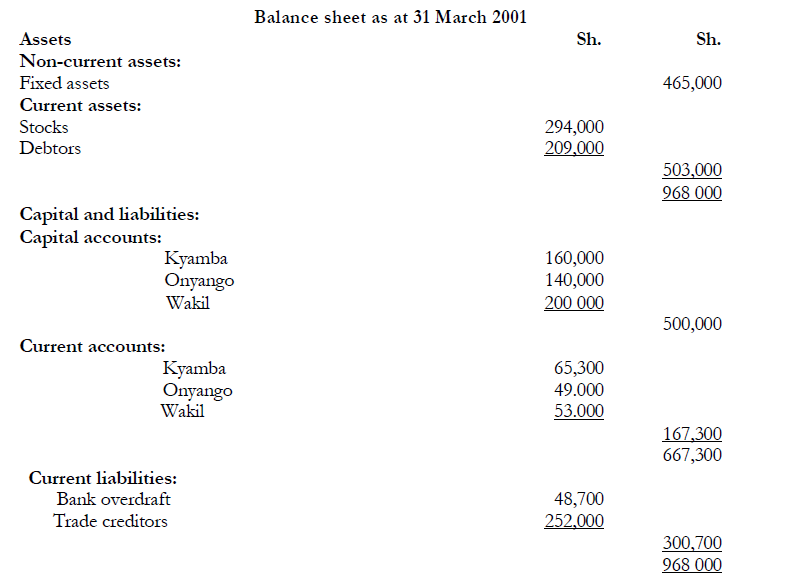 1. On 1 April 2001. Wakil retired from the partnership and was to start a business as a
sole trader while Kyamba and Onyango continued in partnership.
On retirement of Wakil, the manufacturing business was transferred to hum while
Kyamba and Onyango continued with the retail business.
2. The assets and liabilities transferred to Wakil were as follows:
1. On 1 April 2001. Wakil retired from the partnership and was to start a business as a
sole trader while Kyamba and Onyango continued in partnership.
On retirement of Wakil, the manufacturing business was transferred to hum while
Kyamba and Onyango continued with the retail business.
2. The assets and liabilities transferred to Wakil were as follows:
 Wakil obtained a loan from a commercial bank and paid into the partnership the
net amount due from him.
On retirement of Wakil from the partnership, goodwill was valued at Sh.200, 000 but
was not to be maintained in the books of the partnership of Kyamba and Onyango.
After retirement of Wakil on 1 April 2001. Kyamba and Onyango agreed on the
following terms and details of the new partnership:
Kyamba and Onyango to introduce additional capital of Sh.48,000 and
Sh.68,000 respectively.
Each partner was entitled to interest on capital at 10% per annum with effect
from 1 April 2001 and the balance
of the profits was to be shared equally after allowing for annual salaries of
Sh.72,000 to Kyamba and Sh.60,000 to Onyango.
5. The profit of the new partnership before interest on capitals and partners' salaries was
Sh.240, 000 for the year ended 31 March 2002.
6. The profits made by the new partnership increased stocks by Sh.100.000; debtors by
Sh.90.000 and bank balance by Sh.50, 000.
7. Drawings by the partners in the year were Kyamba Sh.85, 000 and OnyanSh go.70,000.
Required:
(a) Profit and loss and appropriation account for the year ended 31 March 2002.
(b) Capital accounts for the year ended 31 March 2002.
(c) Current accounts for the year ended 31 March 2002.
(d) Balance sheet of the new partnership as at 31 March 2002.
Wakil obtained a loan from a commercial bank and paid into the partnership the
net amount due from him.
On retirement of Wakil from the partnership, goodwill was valued at Sh.200, 000 but
was not to be maintained in the books of the partnership of Kyamba and Onyango.
After retirement of Wakil on 1 April 2001. Kyamba and Onyango agreed on the
following terms and details of the new partnership:
Kyamba and Onyango to introduce additional capital of Sh.48,000 and
Sh.68,000 respectively.
Each partner was entitled to interest on capital at 10% per annum with effect
from 1 April 2001 and the balance
of the profits was to be shared equally after allowing for annual salaries of
Sh.72,000 to Kyamba and Sh.60,000 to Onyango.
5. The profit of the new partnership before interest on capitals and partners' salaries was
Sh.240, 000 for the year ended 31 March 2002.
6. The profits made by the new partnership increased stocks by Sh.100.000; debtors by
Sh.90.000 and bank balance by Sh.50, 000.
7. Drawings by the partners in the year were Kyamba Sh.85, 000 and OnyanSh go.70,000.
Required:
(a) Profit and loss and appropriation account for the year ended 31 March 2002.
(b) Capital accounts for the year ended 31 March 2002.
(c) Current accounts for the year ended 31 March 2002.
(d) Balance sheet of the new partnership as at 31 March 2002.
Date posted: November 17, 2018.
- The following information has been extracted from the accounts of Madaraka Investments Ltd.
for the year ended 31 December 2001. Comparable figures for the previous year...(Solved)
The following information has been extracted from the accounts of Madaraka Investments Ltd.
for the year ended 31 December 2001. Comparable figures for the previous year are also shown.
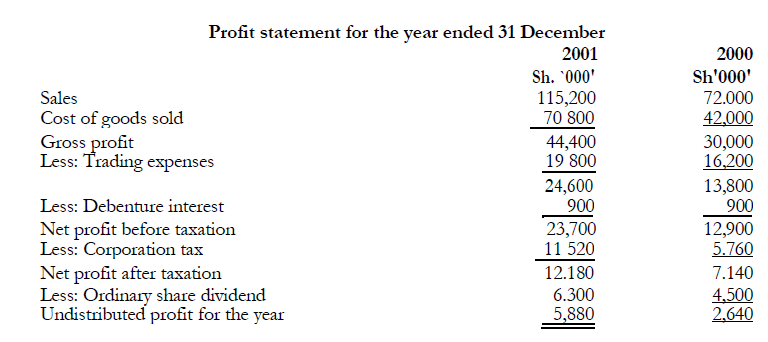
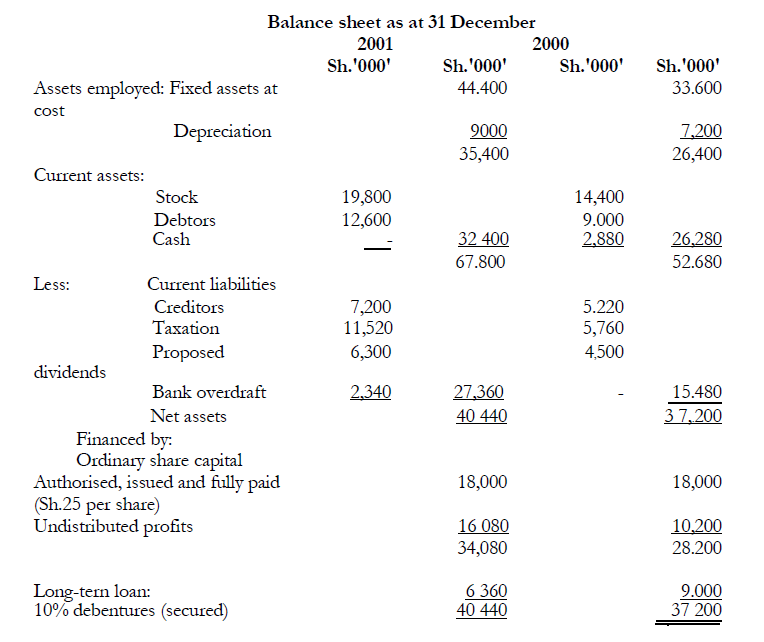 Required:
(a) Calculate six accounting ratios for both 2000 and 2001 that would help in assessing
the profitability and liquidity positions of Madaraka Investments Ltd. (12 marks)
(b) Comment on Madaraka Investment's liquidity position. (4 marks)
(c) Comment on Madaraka Investment's profitability position. (4 marks)
Required:
(a) Calculate six accounting ratios for both 2000 and 2001 that would help in assessing
the profitability and liquidity positions of Madaraka Investments Ltd. (12 marks)
(b) Comment on Madaraka Investment's liquidity position. (4 marks)
(c) Comment on Madaraka Investment's profitability position. (4 marks)
Date posted: November 17, 2018.
- On 31 December 2001. an inexperienced book-keeper working for Wanji, a sole trader,
extracted a trial balance. Due to errors committed by the book-keeper, the trial...(Solved)
On 31 December 2001. an inexperienced book-keeper working for Wanji, a sole trader,
extracted a trial balance. Due to errors committed by the book-keeper, the trial balance failed to
balance by Sh.369.400. He placed the difference in a suspense account as shown below:
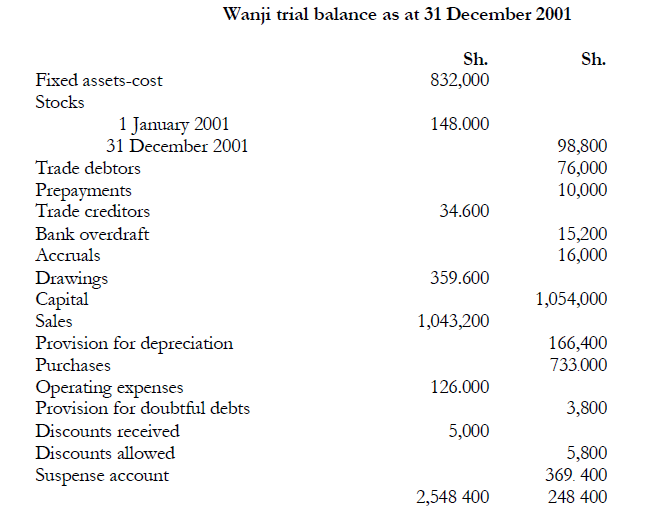 Investigations carried out after preparing the above trial balance detected the following errors:
1. The total of the sales day book for December 2001 was overcast by Sh.25,700.
2. On 2 July 2001 the business purchased office equipment for Sh.40 .000. These were
debited to purchases account.
3. Depreciation on the equipment is at the rate of 10% per annum on cost and based on
the period (months) of usage in the year.
4. A payment to a creditor by cheque of Sh.8.500 was erroneously credited to the
creditor's account.
5. A payment of Sh.4.500 for telephone expenses was debited to telephone account as
Sh.5.400.
6. An amount of Sh.15.000 received from a debtor was not posted to the
debtor's account from the cash book.
7. An amount of discounts received of Sh.2.500 was debited to discounts
allowed account.
8. Purchases day book for October 2001 was undercast by Sh.28,000.
9. Assume the business had reported a net profit of Sh.85,800 before adjusting for the
above errors.
Required:
(a) The adjusted trial balance and the correct balance of the suspense account
(b) Journal entries to correct the errors (Narrations not required)
(c) Suspense account starting with the balance determined in the adjusted trial balance in (a)above.
(d) The adjusted net profit for the year.
Investigations carried out after preparing the above trial balance detected the following errors:
1. The total of the sales day book for December 2001 was overcast by Sh.25,700.
2. On 2 July 2001 the business purchased office equipment for Sh.40 .000. These were
debited to purchases account.
3. Depreciation on the equipment is at the rate of 10% per annum on cost and based on
the period (months) of usage in the year.
4. A payment to a creditor by cheque of Sh.8.500 was erroneously credited to the
creditor's account.
5. A payment of Sh.4.500 for telephone expenses was debited to telephone account as
Sh.5.400.
6. An amount of Sh.15.000 received from a debtor was not posted to the
debtor's account from the cash book.
7. An amount of discounts received of Sh.2.500 was debited to discounts
allowed account.
8. Purchases day book for October 2001 was undercast by Sh.28,000.
9. Assume the business had reported a net profit of Sh.85,800 before adjusting for the
above errors.
Required:
(a) The adjusted trial balance and the correct balance of the suspense account
(b) Journal entries to correct the errors (Narrations not required)
(c) Suspense account starting with the balance determined in the adjusted trial balance in (a)above.
(d) The adjusted net profit for the year.
Date posted: November 17, 2018.
- The accounting profession has for a long time relied on certain accounting conventions to guide
accounting practice. Yet the application of the sane conventions has been...(Solved)
The accounting profession has for a long time relied on certain accounting conventions to guide
accounting practice. Yet the application of the sane conventions has been the source of criticism
of the quality and relevance of information contained in financial reports.
Some of these conventions include:
(a) The business entity principle.
(h) The historical cost principle.
(c) The monetary principle.
(d) The matching principle.
(e) The conservatism principle.
Required:
For each of the principles listed above:
(a) Explain its meaning.
(b) Justify its use.
(c) Explain any weaknesses associated with its use.
Date posted: November 16, 2018.
- Ssemakula, a sole trader received his bank statement for the month of June 2001. At
that date the bank balance was Sh.706,500 whereas his cash book...(Solved)
Ssemakula, a sole trader received his bank statement for the month of June 2001. At
that date the bank balance was Sh.706,500 whereas his cash book balance was
Sh.2,366,500. His accountant investigated the matter and discovered the following
discrepancies:
1. Bank charges of Sh.3, 000 had not been entered in the cashbook.
2. Cheques drawn by Ssemakula totaling Sh.22,500 had not yet been
presented to the bank
3. He had not entered receipts of Sh.26,500 in his cashbook.
4. The bank had not credited Mr. Ssemakula with receipts of Sh.98, 500 paid into the bank
on 30 June 2001.
5. Standing order payments amounting to Sh.62, 000 had not been
entered into the cashbook.
6. In the cash book Ssemakula had entered a payment of Sh.74, 900
Sh.79400.
7. A cheque for Sh. 15,000 from a debtor had been returned by the bank ma rked "refer to
drawer" but had not been written back into the cashbook.
8. Ssemakula had brought forward the opening cash balance of Sh.329, 250 as a debit
balance instead of a credit balance.
9. An old cheque payment amounting to Sh.44, 000 had been written back in the
cashbook but the bank had already honoured it.
10. Some of Ssemakula's customers had agreed to settle their debts by paying directly into
his bank account. Unfortunately, the bank had credited some deposits amounting to
Sh.832, 500 to another customer's account. However, acting on information from his
customers, Ssemakula had actually entered the expected receipts from the debtors in his
cashbook.
Required:
(i) A statement showing Ssemakula's adjusted cash book balance as at 30 June 2001.
(ii) A bank reconciliation statement as at 30 June 2001.
Date posted: November 16, 2018.
- Explain the term "bank reconciliation" and state the reasons for its preparation(Solved)
Explain the term "bank reconciliation" and state the reasons for its preparation.
Date posted: November 16, 2018.
- The accountant of Mamba Sports Club has extracted the following information from
the books of account for the year ended 31 March 2001:(Solved)
The accountant of Mamba Sports Club has extracted the following information from
the books of account for the year ended 31 March 2001:
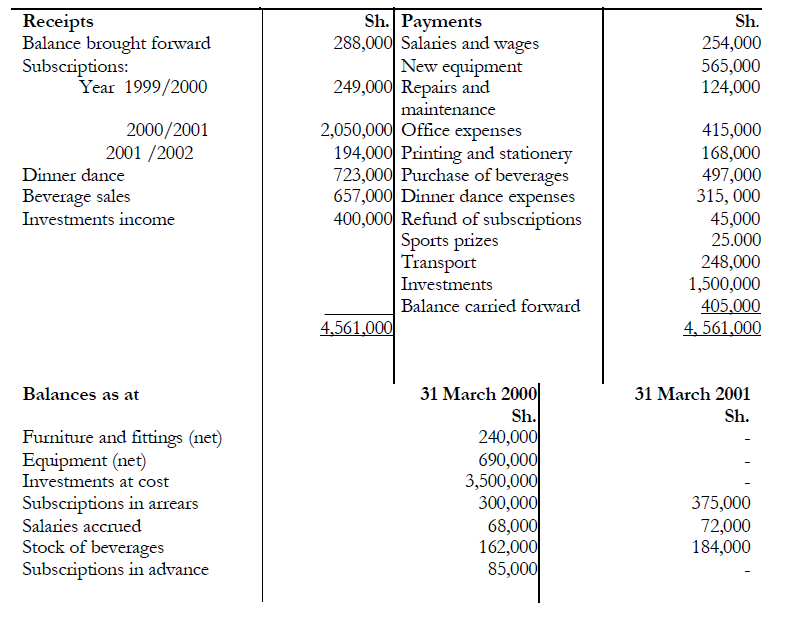 Additional information:
1. Subscriptions in arrears are written-off after twelve months.
2. Depreciation is provided for on reducing balance method at 10% and 20% per
annum on furniture and fittings and equipment respectively.
3. Investments, which had cost Sh.500, 000 were sold on 30 March 2001 for Sh.625,000. No entries have been made in the books in this respect.
Required:
(a) Income and expenditure account for the year ended 31 March 2001.
(b) Balance sheet as at 31 March 2001.
Additional information:
1. Subscriptions in arrears are written-off after twelve months.
2. Depreciation is provided for on reducing balance method at 10% and 20% per
annum on furniture and fittings and equipment respectively.
3. Investments, which had cost Sh.500, 000 were sold on 30 March 2001 for Sh.625,000. No entries have been made in the books in this respect.
Required:
(a) Income and expenditure account for the year ended 31 March 2001.
(b) Balance sheet as at 31 March 2001.
Date posted: November 16, 2018.
- Rotich and Sinei have been in partnership for several years, sharing profits and losses in the
ratio 2:1. Interest on fixed capitals was allowed at the...(Solved)
Rotich and Sinei have been in partnership for several years, sharing profits and losses in the
ratio 2:1. Interest on fixed capitals was allowed at the rate of 10% per annum, but no interest
was charged or allowed on current accounts.
The following was the partnership trial balance as at 30 April 2001:
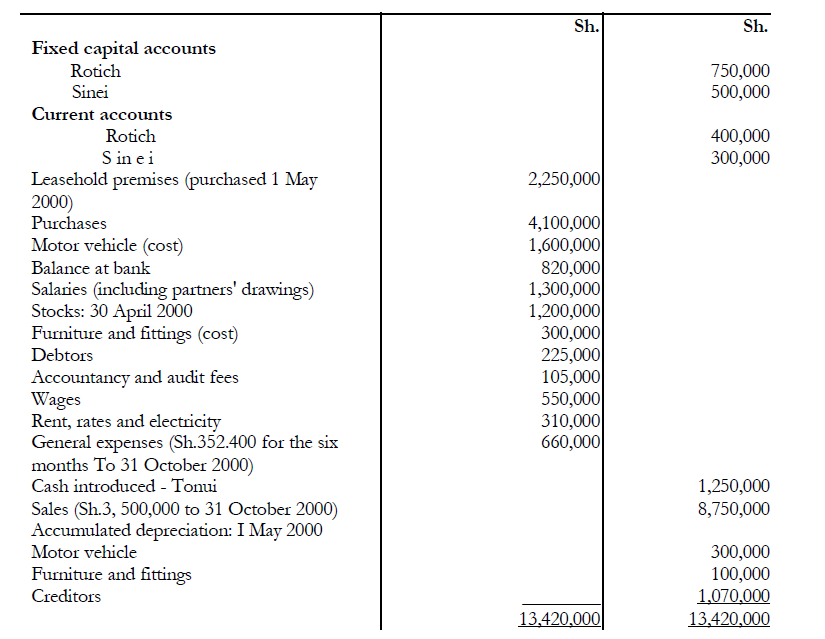 Additional information:
1. On 1 November 2000,'Tonui was admitted as a partner and from that date, profits and
losses were shared in the ratio 2:2:1. For the purpose of' this admission, the value of
goodwill was agreed at Sh.3, 000,000. No account for goodwill was to be maintained in the
books, adjusting entries for transactions between the partners being made in their current
accounts. On that date, Tonui introduced Sh.1, 250,000 into the firm of which Sh.375, 000
comprised his fixed capital and the balance was credited to his current account
2. Interest on fixed capitals was still to be allowed at the rate of 10`%, per annum after Tonui
admission, no interest was to be charged or allowed on current accounts.
3. Any apportionment of gross profit was to he made on the basis of sales. Expenses, unless
otherwise indicated, were to be apportioned on a time basis.
4. A charge was to be made for depreciation on motor vehicle and furniture and fittings at
20%and I0% per annum respectively, calculated on cost.
5. On 30 April 2001, the stock was valued at Sh. 1,275,000.
6. Salaries included the following partners' drawings:
Rotich Sh.150,000 , Sinei Sh. 120,000 and Tonui Sh.62,500
7. A difference in the books of Sh.48, 000 had been written off at 30 April 2001 to
general expenses, which was later found to be due to the following clerical errors:
- Sales returns of Sh.32, 000 had been debited to sales returns but had not
been posted to the account of the customer concerned;
- The purchases journal had been under cast by Sh.80, 000.
8 Doubtful debts (for which full provision was required) amounted to Sh.30, 000 and Sh.40,
000 as at 31 October and 30 April 2001 respectively.
8. On 30 April 2001, rates and rent paid in advance amounted to Sh.50,000 and a provision
of' Sh.15,000 for electricity consumed was required.
Required:
(a) Trading and profit and loss account for the year ended 30 April 2001,
(b) Partners current accounts for the year ended 30 April 2001.
(c) Balance sheet as at 30 April 2001.
Additional information:
1. On 1 November 2000,'Tonui was admitted as a partner and from that date, profits and
losses were shared in the ratio 2:2:1. For the purpose of' this admission, the value of
goodwill was agreed at Sh.3, 000,000. No account for goodwill was to be maintained in the
books, adjusting entries for transactions between the partners being made in their current
accounts. On that date, Tonui introduced Sh.1, 250,000 into the firm of which Sh.375, 000
comprised his fixed capital and the balance was credited to his current account
2. Interest on fixed capitals was still to be allowed at the rate of 10`%, per annum after Tonui
admission, no interest was to be charged or allowed on current accounts.
3. Any apportionment of gross profit was to he made on the basis of sales. Expenses, unless
otherwise indicated, were to be apportioned on a time basis.
4. A charge was to be made for depreciation on motor vehicle and furniture and fittings at
20%and I0% per annum respectively, calculated on cost.
5. On 30 April 2001, the stock was valued at Sh. 1,275,000.
6. Salaries included the following partners' drawings:
Rotich Sh.150,000 , Sinei Sh. 120,000 and Tonui Sh.62,500
7. A difference in the books of Sh.48, 000 had been written off at 30 April 2001 to
general expenses, which was later found to be due to the following clerical errors:
- Sales returns of Sh.32, 000 had been debited to sales returns but had not
been posted to the account of the customer concerned;
- The purchases journal had been under cast by Sh.80, 000.
8 Doubtful debts (for which full provision was required) amounted to Sh.30, 000 and Sh.40,
000 as at 31 October and 30 April 2001 respectively.
8. On 30 April 2001, rates and rent paid in advance amounted to Sh.50,000 and a provision
of' Sh.15,000 for electricity consumed was required.
Required:
(a) Trading and profit and loss account for the year ended 30 April 2001,
(b) Partners current accounts for the year ended 30 April 2001.
(c) Balance sheet as at 30 April 2001.
Date posted: November 16, 2018.
- Nafuu Foods Ltd. is a company in the hospitality industry. The following trial balance has
been extracted from its books on 31 October 2001(Solved)
Nafuu Foods Ltd. is a company in the hospitality industry. The following trial balance has
been extracted from its books on 31 October 2001:
You are provided with the following additional information:
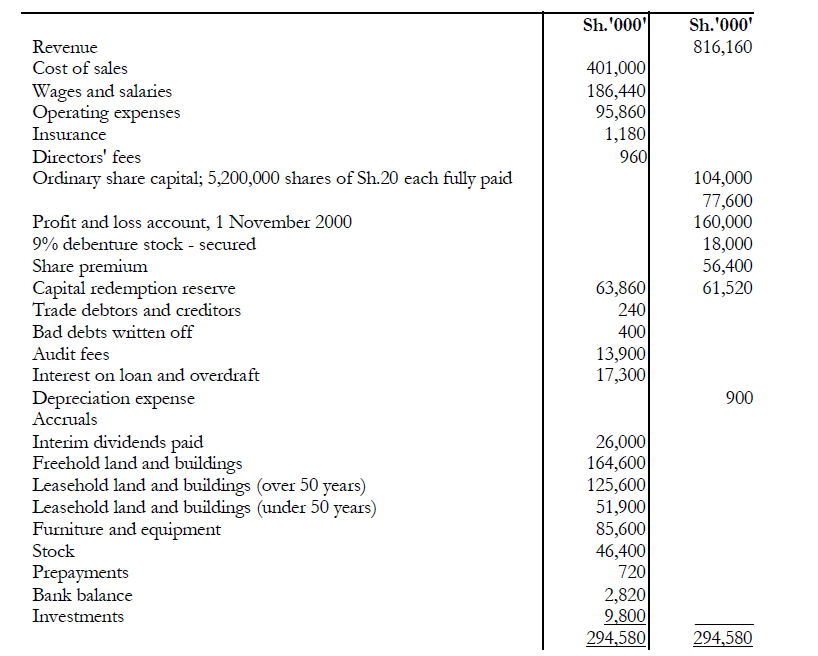 1. The balances of fixed asset accounts as at the beginning of the year and additions during
the year were as follows:
1. The balances of fixed asset accounts as at the beginning of the year and additions during
the year were as follows:
 a. The company does not provide for depreciation on freehold properties or
properties held on lease with 50 years or more to run at the balance sheet date.
Properties held on lease with less than 50 years to run are depreciated over the
unexpired term. Items of equipment are depreciated over their estimated useful
life.
2. Some of the leasehold property in the books costing Sh.7, 500,000 had just 50 years
remaining on the lease in October 2000 and has not yet been transferred to the under
50 years category.
3. Disposals during the year included the following:
a. The company does not provide for depreciation on freehold properties or
properties held on lease with 50 years or more to run at the balance sheet date.
Properties held on lease with less than 50 years to run are depreciated over the
unexpired term. Items of equipment are depreciated over their estimated useful
life.
2. Some of the leasehold property in the books costing Sh.7, 500,000 had just 50 years
remaining on the lease in October 2000 and has not yet been transferred to the under
50 years category.
3. Disposals during the year included the following:
 All the sale proceeds have been included in the revenue; no other adjustment has
been made.
The determination of depreciation expense for the year included in the trial balance
above has correctly been done for those properties not disposed of and included in
the under 50 years category at the beginning of the year.
4. Freehold land was revalued on an existing use basis by a professional valuer but the
Surplus of Sh.6,000.000 has not yet been brought into account.
5. The investments in the trial balance are temporary quoted securities. As at 31
October 2001 their market value was Sh.10,500,000. Income from the investments
of Sh.450,000 is included in revenue
6. Additional audit fees of Sh.600,000 need to be provided for.
7. The total balance of cash at bank includes Sh. 1,500,000 overdraft on one of the
accounts.
8. The corporation tax oil the year's profit has been estimated at Sh.27,000,000.
Corporation tax on the previous years profit was finally agreed with the tax authorities
to be Sh.3 10,000 more than had been provided for in the profit and loss account of
the year.
The directors have decided to recommend a final dividend of Sh.5 per ordinary share.
Required:
(a) A schedule showing fixed assets movements for the year ended 31 October 2001.
(b) Profit and loss account for the year ended 31 October 2001.
(c) Balance sheet as at 31 October 2001.
All the sale proceeds have been included in the revenue; no other adjustment has
been made.
The determination of depreciation expense for the year included in the trial balance
above has correctly been done for those properties not disposed of and included in
the under 50 years category at the beginning of the year.
4. Freehold land was revalued on an existing use basis by a professional valuer but the
Surplus of Sh.6,000.000 has not yet been brought into account.
5. The investments in the trial balance are temporary quoted securities. As at 31
October 2001 their market value was Sh.10,500,000. Income from the investments
of Sh.450,000 is included in revenue
6. Additional audit fees of Sh.600,000 need to be provided for.
7. The total balance of cash at bank includes Sh. 1,500,000 overdraft on one of the
accounts.
8. The corporation tax oil the year's profit has been estimated at Sh.27,000,000.
Corporation tax on the previous years profit was finally agreed with the tax authorities
to be Sh.3 10,000 more than had been provided for in the profit and loss account of
the year.
The directors have decided to recommend a final dividend of Sh.5 per ordinary share.
Required:
(a) A schedule showing fixed assets movements for the year ended 31 October 2001.
(b) Profit and loss account for the year ended 31 October 2001.
(c) Balance sheet as at 31 October 2001.
Date posted: November 16, 2018.
- You have been asked to advise on the appropriate accounting treatment for the following
situations arising in the books of various companies. The year end in...(Solved)
You have been asked to advise on the appropriate accounting treatment for the following
situations arising in the books of various companies. The year end in each case can be taken as
30 April 2001 and you should assume that the amounts involved are material.
Required:
For each of the situations below, outline the accounting treatment you would recommend and
give the reasoning principles involved.
a) At the year end there was a debit balance in the books of a company for Sh.150,000
representing an estimate of the amount receivable from an insurance company for an
accident claim. In May 2001 before the directors had agreed on the final draft of the
published accounts, the amount of the claim was finally settled as Sh.186,000.
b) A company has an item of equipment which cost Sh.4,000,000 in 1999 and was expected to
last for ten years. At the beginning of the year ended 30 April 2001 the book value was
Sh.2,800,000. It is now thought that the company will soon cease to make the product for
which the equipment was specifically purchased. Its recoverable amount is only Sh.800,000
at 30 April 2001.
c) On 31 March 2001, a company entered into legal action defending a claim for supplying
faulty machinery. The company‟s lawyers advise that there is a 20% probability that
the claim will succeed. The amount of the claim is Sh.5,000,000.
d) An item has been produced at a manufacturing cost of Sh.18,000 against a
customer‟s order at an agreed price of Sh.23,000. The item was in stock at the year end
awaiting delivery against instructions. In May 2001, the customer was declared bankrupt and the
most reasonable course of action seems to be to make a modification to the unit, costing
approximately Sh.3,000 which is expected to make it marketable with other customers at a
price of about Sh.19,000.
e) At 30 April, the company has a total potential liability of Sh.10,004,000 for warranty work
on contracts. Past experience shows that 10% of these costs are likely to be incurred, 30%
may be incurred but that the remaining 60% is highly unlikely to be incurred.
Date posted: November 16, 2018.
- Kaluwax Ltd. manufactures one product which it sells to the wholesale trade. The following trial
balance was extracted from the books of the company at 30...(Solved)
Kaluwax Ltd. manufactures one product which it sells to the wholesale trade. The following trial
balance was extracted from the books of the company at 30 April 2001:
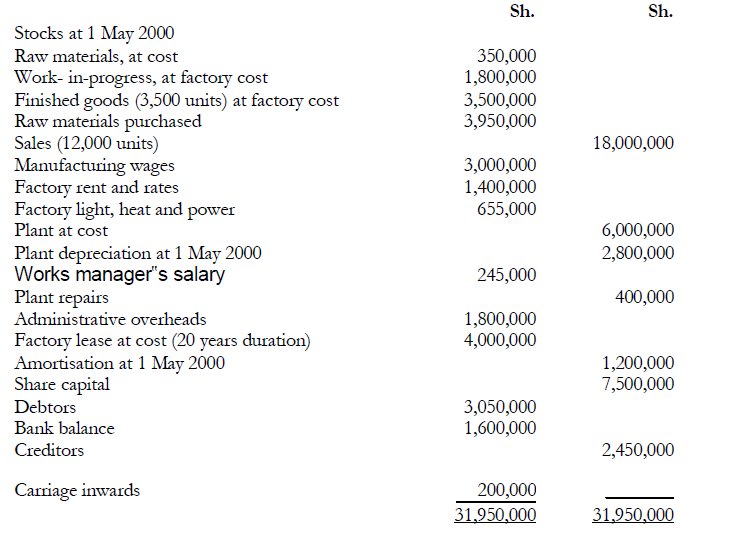 The following additional information is available:
1. Plant depreciation is to be provided at 10% on the cost of plant owned at the year end.
2. Raw materials costing Sh.500,000 were in stock on 30 April 2001.
3. Finished goods are transferred to the warehouse as soon as they are completed. During the
year, 10,000 units were completed and transferred to the warehouse. Work-in-progress at
the end of the financial year (at factory cost) amounted to Sh.2,300,000.
4. There was no wastage or pilferage during the current year.
Required:
a) Manufacturing, trading and profit and loss account for the year ended 30 April 2001.
(12 marks)
b) Assume the facts as in (a) above, except that it had always been the company‟s
practice to transfer completed units from the factory to the warehouse at cost plus 25% and to
value stocks of finished goods at the transfer price for the trading account but at factory cost
for balance sheet purposes. Show how the manufacturing, trading and profit and loss account
for the year ended 30 April 2001 would appear.
The following additional information is available:
1. Plant depreciation is to be provided at 10% on the cost of plant owned at the year end.
2. Raw materials costing Sh.500,000 were in stock on 30 April 2001.
3. Finished goods are transferred to the warehouse as soon as they are completed. During the
year, 10,000 units were completed and transferred to the warehouse. Work-in-progress at
the end of the financial year (at factory cost) amounted to Sh.2,300,000.
4. There was no wastage or pilferage during the current year.
Required:
a) Manufacturing, trading and profit and loss account for the year ended 30 April 2001.
(12 marks)
b) Assume the facts as in (a) above, except that it had always been the company‟s
practice to transfer completed units from the factory to the warehouse at cost plus 25% and to
value stocks of finished goods at the transfer price for the trading account but at factory cost
for balance sheet purposes. Show how the manufacturing, trading and profit and loss account
for the year ended 30 April 2001 would appear.
Date posted: November 16, 2018.
- Kimeu commenced his business of making furniture on 1 April 2000. Due to his limited
accounting knowledge he has not maintained proper books of account. You...(Solved)
Kimeu commenced his business of making furniture on 1 April 2000. Due to his limited
accounting knowledge he has not maintained proper books of account. You have been engaged
to examine his records and prepare appropriate accounts therefrom. You perform an
examination of the records and from interviews with Kimeu, you ascertain the following
information:
1. At the commencement of business on 1 April 2000, he deposited Sh.1,200,000 into a
business bank account. On the same day he brought into the firm his pickup and estimated
that it was worth Sh.660,000 then and that from 1 April 2000 it will have useful life of three
years.
2. To increase his working capital he borrowed Sh.400,000 at 15% interest per annum on 1
July 2000 from his sister but no interest has yet been paid.
3. On 1 April 2000, Sally was employed as a clerk at a salary of Sh.720,000 per annum.
4. He had drawn Sh.18,000 per week from the business account for private use during the
year.
5. He purchased timber worth Sh.1,960,000 out of which Sh.158,000 worth of stock was
retained in the workshop on 31 March 2001. He also spent Sh.960,000 on the purchase of
some equipment at the commencement of the business which he estimates will last him five
years.
6. Electricity bills received up to 31 January 2001 were Sh.240,000. Bills for the remaining two
months were estimated to be Sh.48,000. Motor vehicle expenses were Sh.182,000 while
general expenses amounted to Sh.270,000 for the year. Insurance premium for the year to
30 June 2001 was Sh.160,000. All these expenses have been paid by cheque.
7. Rates for the year to June 2001 were Sh.36,000 but these had not been paid.
8. Sally sent out invoices to customers for Sh.6,178,000 but only Sh.5,080,000had been
received by 31 March 2001. Debts totalling to Sh.17,000 were abandoned during the year as
bad. Other customers for jobs too small to invoice have paid Sh.726,000 in cash for work
done of which Sh.560,000 was banked . Kimeu used Sh.75,000 of the difference to pay for
his family‟s food stuff bought Kenya Charity Sweepstake tickets worth
Sh.24,000 and Sally used the rest on general expenses except for Sh.30,100 which was left
over in the drawer in the office on 31 March 2001.
9. You agree with Kimeu that he will pay you Sh.55,000 for accountancy fee.
Required:
a) Profit and loss account for the year ended 31 March 2001.
b) Balance sheet as at 31 March 2001.
Date posted: November 16, 2018.
- The Wide Trading Company Limited has an authorised capital of Sh.500,000 divided into
5,000 ordinary shares of Sh.100 each.
On 1 January 2001, the Board of directors...(Solved)
The Wide Trading Company Limited has an authorised capital of Sh.500,000 divided into
5,000 ordinary shares of Sh.100 each.
On 1 January 2001, the Board of directors decided to issue 4,000 shares at Sh.125 each
payable as Sh.50 on application. Sh.50 on allotment (including the Sh.25 premium) and
Sh.25 on first and final call. The applications were receivable on 20 January 2001 when
allotment was made. The allotment money was receivable by 15 February 2001. The first
and final call was made on 15 March 2001 and the call money receivable by 31 March 2001.
Applications were received for 6,000 shares. The directors decided to refund money for
1,000 shares and the other applicants were allotted prorata with the excess money utilised to
meet part of the allotment money. The balance of the allotment money was received on the
due date. The first and final call was made and the call money received on the due date
except for allotees of 200 shares.
The 200 shares with calls arrears were forfeited on 10 April 2001 and sold for cash at Sh.85
eacg ib 12 April 2001.
Note: No other transactions took place during the above period.
Required:
i) Application and Allotment Account, First and Final Call Account, Ordinary Share
Capital Account. Share Premium Account, Calls in Arrears Account. Forfeited Shares
Account and the bank account.
ii) Balance sheet as at 12 April 2001
Date posted: November 16, 2018.
- Explain the following terms: (i) Share premium (ii) Rights issue(Solved)
Explain the following terms: (i) Share premium (ii) Rights issue
Date posted: November 16, 2018.
- Atieno, Babu and Chesire have been trading in partnership sharing profits/losses in the ration of
5:3:2 respectively. On 1 April 2000 they admitted their manager, Dagana...(Solved)
Atieno, Babu and Chesire have been trading in partnership sharing profits/losses in the ration of
5:3:2 respectively. On 1 April 2000 they admitted their manager, Dagana as a partner and the
profit sharing ratio was changed to 4:3:2:1 FOR Atieno, Babu, Chesire and Dagana respectively.
The partners valued the goodwill at Sh.510,000. Dagana paid Sh.200,000 as capital and his share
of goodwill, which should be based on capital contributions.
The partners do not wish to retain the goodwill account after admission of Dagana. The
admission of Dagana has not been fully recorded other than the cash receipt of Sh.376,500.
The following is the trial balance of the partnership as at 31 March 2001:
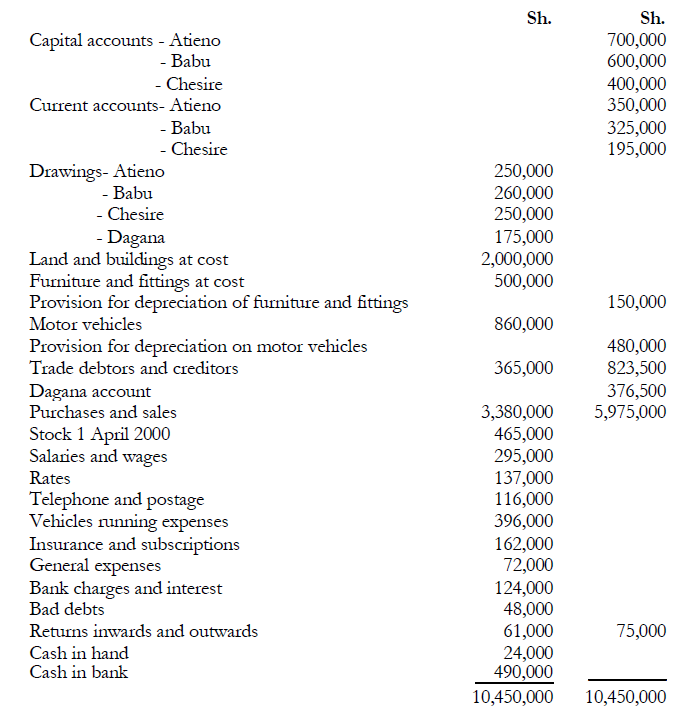 Notes:
1) Depreciation on furniture and fittings and motor vehicles is at 10% and 20% on reducing
balance respectively.
2) The closing stocks were valued at Sh.560,000.
3) Accrued salaries and wages and telephone bills amounted to Sh.24,000 and Sh.14,000
repectively.
4) Prepaid subscriptions and rates amounted to Sh.5,000 and Sh.25,000 respectively.
5) The partners decided that Dagana should be given a monthly salary of Sh.20,000 for the
whole year from 1 April 2000 to 31 March 2001.
6) Dagana took goods for own use at cost amounting to Sh.185,000. No entry has been made
in the books.
7) The old partners shared the cash paid by Dagana for part of his goodwill.
Required:
a) Trading, profit and loss account for the year ended 31 March 2001. (10 marks)
b) Partners capital accounts.
c) Partners current accounts.
d) Balance sheet as at 31 March 2001.
Notes:
1) Depreciation on furniture and fittings and motor vehicles is at 10% and 20% on reducing
balance respectively.
2) The closing stocks were valued at Sh.560,000.
3) Accrued salaries and wages and telephone bills amounted to Sh.24,000 and Sh.14,000
repectively.
4) Prepaid subscriptions and rates amounted to Sh.5,000 and Sh.25,000 respectively.
5) The partners decided that Dagana should be given a monthly salary of Sh.20,000 for the
whole year from 1 April 2000 to 31 March 2001.
6) Dagana took goods for own use at cost amounting to Sh.185,000. No entry has been made
in the books.
7) The old partners shared the cash paid by Dagana for part of his goodwill.
Required:
a) Trading, profit and loss account for the year ended 31 March 2001. (10 marks)
b) Partners capital accounts.
c) Partners current accounts.
d) Balance sheet as at 31 March 2001.
Date posted: November 16, 2018.